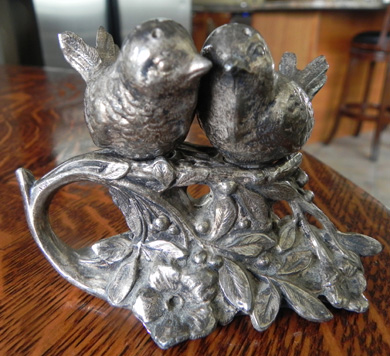 |
|
|||
 |
 |
|||
Copyright © Harry Rinker, LLC 2016 Questions
and Answers
ANSWER: Leonard B. Shearer founded a cabinetmaker’s shop, located on Blackstone Street in Boston, in 1835. John S. Paine was his apprentice. By the end of the nineteenth century, Paine Furniture was a major American furniture manufacturer. The Boston Public Library’s 1880 Paine’s Furniture Company 170-page catalog is available on the internet. (https://archive.org/details/painesfurniturec00pain) Although Colonial Revival, generic, and Aesthetic design style pieces are present, Renaissance Revival design style furniture dominates. The wide range of forms and shapes is a testament to the breadth of furniture forms and shapes made by a large late-nineteenth century furniture manufacturer. There was no evidence of your Boston-style rocker. In 1914, Paine built a ten-story, Classical Revival style building, designed by Densmore and LeClear, at 75-81 Arlington Street (consuming the entire block between St. James and Stuart) in Boston. The building housed the manufacturing, offices, and showroom for Paine Furniture. Paine Furniture sold the building in 1989. It was added to the National Register of Historic Places in 2002. Paine Furniture is now Paine’s Patio, established by a sixth generation of the Shearer family in 2003. The store is located in Bourne, Massachusetts. To understand the wide variety of Paine Furniture, check www.WorthPoint.com. WorthPoint.com has more than 70 images of Paine Furniture sold at auction in design styles ranging from the late Victorian era to 20th-century to Colonial Revival to post-1945 Modernism. Although the secondary market for Paine Furniture is national, the strongest auction prices occur in New England. An internet search revealed more than a dozen Paine Furniture labels used during its history. Unfortunately, none were dated. My best guess is the “66/1013” mark on the paper label means 1966 and inventory number 1013.
WorthPoint.com contains a listing for an early 20th-century Colonial Revival brace back Windsor chair that sold on eBay for $200.00. Leslie Hindman Auctioneers sold a Windsor-style chair for $40.00 in August 2006. Top dollar for Paine Furniture pieces is restricted to full dining room suites and large cabinet pieces. Your Paine Furniture Company Boston-style Windsor rocker has a value between $70.00 and $90.00.
ANSWER: I spent over half an hour searching the internet. Every search word or combination resulted in negative results. Instead of getting frustrated, I dipped into my contact file and called Dawn Herlocker, a friend and author of “200 Years of Dolls: Identification and Price Gide, 3rd Edition” published by KP (Krause Publications). I sent her the images that accompanied your email. In my email to Dawn, I suggested the doll dated from the 1941-1945 period. Dawn replied that I should expand my date horizons to the late 1940s / early 1950s. She noted the later period was when “mask face dolls” were popular. The key to searching the internet is knowing the correct terminology. I immediately did a search of “mask face dolls” and was rewarded with a large number of images. Your plush face doll was not among them.
As to maker, Dawn noted there were 2,000 to 3,000 “unidentified/unknown” doll makers from the 1930s through the 1950s. If pressed to identify a single maker, Dawn suggested looking into the Sterling Doll Company. The Sterling Doll Company made personality (Babe Ruth, Knute Rockne, Red Granger) and boudoir dolls in the 1920s and 1930s. Specific information about the company is scarce. As before, knowing what to ask often reveals critical information. I did a search using “military doll +Sterling Doll Company.” While I did not find your Army doll, I did find the following query on www.usmilitariaforum.com: “I have a doll…made by Sterling Doll company and it’s marked Sterling Doll Co. on the back of the neck… It has a soft plush body….a black hat, and the uniform is a navy blue with no badges for rank or even buttons….It has a hard plastic face/head….” Bingo. It has to be a companion piece to the doll you purchased. When I teach pricing philosophy at the Institute for the Study of Antiques and Collectibles, I talk about WOW/PIZZAZZ value as one of the sub-values of Decorative Value. Your Army plush doll does have WOW value, especially given its size. It also has “Neat Thing” value. It is a great conversation piece. While WOW is a value, it does not always result in a substantial financial value. Dawn suggested a value between $30.00 and $35.00. I like it better. $50.00 would be pushing it. QUESTION: When my mother worked in Washington, DC, in 1948-49, she purchased a centerpiece silver plated salt and pepper set consisting of two birds sitting atop an elaborate leafed branch base. There are two marks on the bottom. The first is an elongated shield with initial that I cannot make out and the number “121.” The second is “PAT. APPLD FOR.” They are badly tarnished. I would like any information as to value. – SS, Bozeman, MT
ANSWER: Because the centerpiece salt and pepper set is silver plated, it has minimal value. The “121” is a stock number. I enlarged the mark but was not able to clearly distinguish the letters or numbers within it. Given the time period when the centerpiece set was acquired, I suspect it was an inexpensive European or Japanese import. “PAT. APPLD For” does not necessarily signify manufactured in the United States, only that the manufacturer had applied for a U.S. patent. The set has no value tarnished. Normally, I would not recommend using a dip or metal electrolytic cleaning plate for any metal product. Because of the minimal value of piece, even polished, you have little to lose. Expose the piece to the electrolytic cleaning plate or dip for only a few seconds. Wash the tarnish off quickly. Try to preserve as much of the silver plate as possible. Even if it polishes nicely, the two birds salt and pepper centerpiece is only worth between $10.00 and $15.00.
QUESTION: I have a Flexible Flyer sled that was made in West Point, Mississippi. It measures 22-inches wide by 47-inches long. It is marked “R6889.” Do you know its value? AG, Email Question ANSWER: S. L. Allen, located in Cinnaminson, New Jersey, made Flexible Flyer sleds. Leisure Group of Los Angeles, California acquired S. L. Allen in 1968. At that point, sleds were being produced in Media, Ohio. A private investor group bought Leisure Group in 1973 and moved production of its “Blazon Flexible Flyer,” as the sled was then known, to West Point, Mississippi. When Roadmaster purchased the production rights to Flexible Flyer in 1993, it moved manufacturing to Olney, Illinois, and in 1998 to China. Given this information, your sled was made between 1973 and 1993. A Flexible Flyer sled this recent is garage/yard sale fodder. Its sole value is reuse. Any value above $10.00 makes the seller a winner.Harry L. Rinker welcomes questions from readers about
collectibles, those mass-produced items from the twentieth and twenty-first centuries.
Selected letters will be answered in this column.
Harry cannot provide personal answers.
Photos and other material submitted cannot be
returned.
Send your questions to: Rinker on Collectibles, 5955 Mill
Point Court SE, Kentwood, MI 49512.
You also can e-mail your questions to
harrylrinker@aol.com.
Only e-mails containing a full name and mailing address
will be considered.
You can listen
and participate in
WHATCHA GOT?, Harry’s
antiques and collectibles radio call-in show, on Sunday mornings between 8:00 AM
and 10:00 AM Eastern Time.
If you
cannot find it on a station in your area,
WHATCHA GOT?
streams live on the Internet at www.gcnlive.com.
SELL, KEEP OR TOSS?: HOW TO DOWNSIZE A HOME,
SETTLE AN ESTATE, AND APPRAISE PERSONAL PROPERTY
(House of Collectibles, an imprint of Random House Information Group, $17.99),
Harry’s latest book, is available at your favorite bookstore and via
www.harryrinker.com.
|
||||
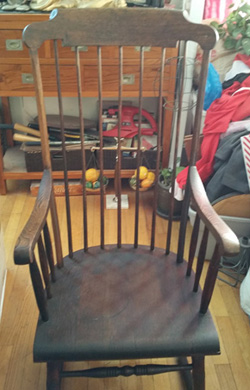 QUESTION: I have a Boston-style Windsor rocker made by the Paine Furniture Company of Boston, Massachusetts. It has two labels on the bottom. The first is a circular paper label with “PAINE FURNITURE COMPANY” in the surround and “MAKERS / OF FINE / FURNITURE / (foliate design) / BOSTON” in the center. Handwritten in a panel at the bottom of the surround is “66/1013.” The second label is metal and reads “Paine Furniture Co. / Boston, Mass.” I am trying to determine a rough estimate of its age and value. – RS, Danvers, MA, Email Question
QUESTION: I have a Boston-style Windsor rocker made by the Paine Furniture Company of Boston, Massachusetts. It has two labels on the bottom. The first is a circular paper label with “PAINE FURNITURE COMPANY” in the surround and “MAKERS / OF FINE / FURNITURE / (foliate design) / BOSTON” in the center. Handwritten in a panel at the bottom of the surround is “66/1013.” The second label is metal and reads “Paine Furniture Co. / Boston, Mass.” I am trying to determine a rough estimate of its age and value. – RS, Danvers, MA, Email Question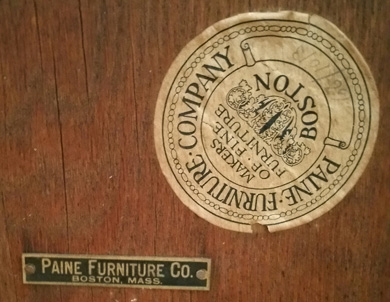
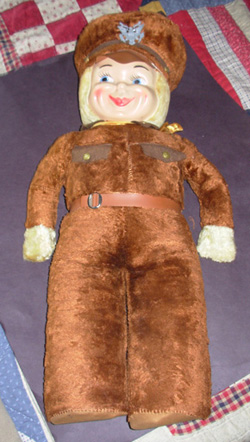 QUESTION: While attending a yard sale in Lancaster County, Pennsylvania, I found what I consider to be a WOW factor doll. The seller was asking $30.00, but we settled on $22.00. The doll is a military doll. The child-like face is an applied plastic mask. The rest of the body is a brown plush, similar to what one would find on a teddy bear. There are no manufacturer’s tags or marks. The dolls is heavy – four pounds, six ounces. There is almost no play wear. I was not able to find anything about this doll on the Internet. Can you help? – BM, Lititz, PA, Email Question.
QUESTION: While attending a yard sale in Lancaster County, Pennsylvania, I found what I consider to be a WOW factor doll. The seller was asking $30.00, but we settled on $22.00. The doll is a military doll. The child-like face is an applied plastic mask. The rest of the body is a brown plush, similar to what one would find on a teddy bear. There are no manufacturer’s tags or marks. The dolls is heavy – four pounds, six ounces. There is almost no play wear. I was not able to find anything about this doll on the Internet. Can you help? – BM, Lititz, PA, Email Question.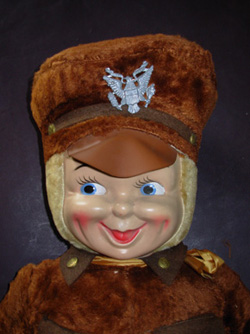 Dawn expressed concern that the military-style winged eagle pin on the hatband was not right. The pin is silver in appearance. The buttons are brass. After receiving Dawn’s response, I enlarged the picture of the hat. The pin appears to be an inexpensive, slush-metal die cast pin and appropriate to what one would expect on this plush doll.
Dawn expressed concern that the military-style winged eagle pin on the hatband was not right. The pin is silver in appearance. The buttons are brass. After receiving Dawn’s response, I enlarged the picture of the hat. The pin appears to be an inexpensive, slush-metal die cast pin and appropriate to what one would expect on this plush doll.